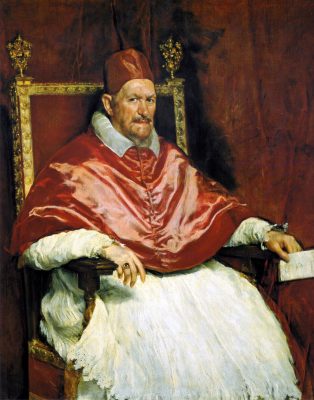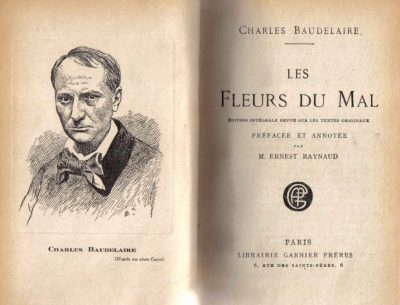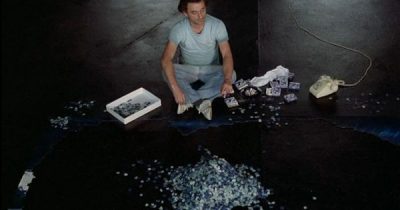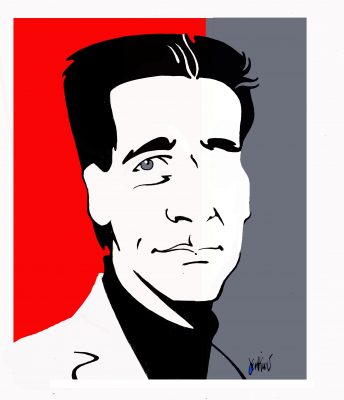By
Robert Kilborn
It was my friend Margaret van Dyck the painter who told me about the Chinese artist who, when a patron visited him in his studio to buy a painting, would without looking up from his work gesture towards the finished canvases leaning against the studio walls. And then, when his patron had made a choice, the artist would, again without looking up from his work, gesture toward a little shelf above his work desk, where the patron could leave the money.
Margaret was a Montreal icon: a female goth-dandy, all black leather, lace, silk and satin, with perfect white teeth behind very red lips and skin as white as milk in a black bowl. For me, she embodied the moral, intellectual, and spiritual aspects of goth-dandyism. Her outward form seemed to encrypt an inner distinction that simultaneously embraced and transcended the material world. In her, the 19th century cult of the self rose above commonplace opposition and revolt. Her gifts were of a kind that neither work nor money could bestow. Her life was that of a legendary flâneur, observor, philosopher, vagabond, who was seen each day exploring the streets of a great city, sketchbook in hand, a city whose colours and lines turned to ash upon her death of breast cancer at age 37.
Margaret once compared the light in the eyes of portraits to the use of sibilants in poetry: “So you see,” she said in her quick, precise, staccato manner, “you can always discern the skill of a poet by observing how he uses the “s” sounds in his poetry, just as you can discern the skill of a portrait painter by observing his use of light in the eyes.”
“Go on,” I said, entranced.
“The greatest portrait painters—Da Vinci, Rembrandt, Velázquez—all knew how to manipulate the light in their subject’s eyes,” Margaret said. “Consider Velázquez’s portrait of Pope Innocent X.”
She pulled a frayed and faded postcard out of her bag—of a portrait, one of the finest ever created, according to many—that she had bought at the Met in New York when she was 20.
“Innocent X objected to ending the Thirty Years’ War—which had killed tens of millions—as it had served the interests of the Vatican. He encouraged the Civil War in England and Ireland, and sent his envoy to Kilkenny with soldiers, sailors, muskets, pistols, swords, twenty-thousand pounds of gunpowder and a very large sum of money. He kept Muslim slaves, burned witches, and treacherously destroyed the lives of all who opposed him. Some say he also invented the useful propaganda of Christians martyred in the Colosseum.”
Oh, my, Margaret. How do I miss thee.
“Look at that rigid, anxious posture: look at those hands: one curves like a claw or talon, the other clamps some horrible edict or other. And the face! It’s like a boiled potato dipped in wine or blood. And the light in the eyes!—the haunted, wary, searching eyes—hardened and bitter beyond cynicism.”
One of her other treasures was a silver and gold Turkish ring of intricately patterned stars and crescents, set with a bright green jasper stone the colour of her eyes. She had haggled for it with a hundred-year-old Armenian woman in an Istanbul bazaar. “This ring expresses unconscious beauty,” she said. “The jeweler had made similar rings in such numbers that he had been liberated from his ego.” Another favourite possession was a yellowing edition of Baudelaire’s Les Fleurs du Mal that she had bought from a louche bouquiniste on the left bank of the Seine near the Quai Voltaire. “The guy leered at me, and quoted from ‘Au Lecteur’: ‘La sottise, l’erreur, le péché, la lésine, / Occupent nos esprits et travaillent nos corps, / Et nous alimentons nos aimables remords, / Comme les mendiants nourrissent leur vermine.’ ” [‘Folly, error, sin, avarice / Occupy our minds and labor our bodies, / And we feed our pleasant remorse / As beggars nourish their vermin.’ ”]
Margaret knew more about Baudelaire and Mozart and The Velvet Underground than the Devil’s grandmother. She would sing Cherubino’s “Non so più cosa son, cosa faccio” from La Nozze di Figaro—“I don’t know any more what I am, what I’m doing, / Now I’m fire, now I’m ice”—or mimic Lou Reed singing Venus in Furs—“Shiny shiny, shiny boots of leather”—in bed. It was she who pointed out a pre-Velvets Nico to me, playing a minor character in Fellini’s La Dolce Vita, exotic and stunning before Warhol, heroin addiction and premature death.
We loved music, books, and movies together. We shed tears over Luc Besson’s Léon: Le Professional, where contract killer Jean Reno sacrifices his life for his 12-year-old soulmate Natalie Portman; and we wallowed in the poignant comedy of Masayuki Suo’s Shall We Dance, where a depressed Japanese salaryman rediscovers poetry in his life through learning how to ballroom dance. We drank afternoon tea at the Ritz Carlton or wine or beer in scorched cafés and noirish after-hours clubs, discussing the metaphysics of black comedy in Pedro Almodóvar’s Women on the Verge of a Nervous Breakdown, or the White Knight character Gorodish in Jean-Jacques Beineix’s Diva. “Despite appearances, Gorodish lives by a stringent code of ethical action,” Margaret said. “He sits monk-like on the floor of his giant and nearly empty loft, assembling vast and complex jigsaw puzzles; he meditates to music, contemplates a room-sized wave machine, and marinates in a hot bath, smoking, while his underage Vietnamese sexually provocative kleptomaniacal girlfriend rollerskates round and round his circling thoughts. Then, suddenly knowing exactly what to do and how to do it, he springs into action, rescues the victims, destroys the villains, and restores equilibrium. He represents an ancient idea, manifested in Sufi and Hasidic and Christian mystical traditions: “One-thousand good men hold up the world.”
Margaret also enjoyed certain blockbusters. She wept over Bruce Willis’s sacrifice for the world, his daughter Liv Tyler and her fiancé Ben Affleck in Armageddon. She called the moment of Willis’s sacrificial death—when in his mind’s eye he sees a montage of images from his daughter’s childhood, maturity, and wedding-to-be flash before him—“sublime”. To doubters, she would insist, “It’s a modern fairy tale, don’t you see? With all the truth and beauty and terror of a traditional fairy tale, but with lots of rapid-cut action and glamorous technology.” She would then add something like, “Humans need heroes. They need faith and hope in the future, or else they would sink into despair.” Sometimes she would continue: “It’s just like that ex-military pilot loser-alcoholic cropduster played by Randy Quaid in Independence Day. He was the only one left at the end who still had the means to attack the invading aliens, and he did so without hesitation and with great courage, kamikaze style, both sacrificing his life and redeeming it. It’s another fairy tale, right down to the ‘Brain’ of Jeff Goldblum’s scientist and the ‘Heart’ of Will Smith’s warrior.”
In literature Margaret had no time for J. K. Rowling, Dan Brown or Stephen King. She thought that slam poetry was the death of art. Poetry must scan, and prose must be as tightly woven as chain armour. She agreed with Ezra Pound that François Villon was “the hardest, most absolute poet of France,” and with T. S. Eliot that James Joyce is “the greatest writer of English prose since Milton.” She adored Shakespeare, Milton, Donne, Blake, Lewis Carroll, Wilde, Tolstoy, Chekhov, Joyce, Proust, Beckett, Kafka and Borges. An amateur of Latin, she would say things like “the medieval theologian Duns Scotus gave the name ‘thisness’ (haecceitas) to individuating form. Detail kills abstraction with palpability.” She loved the televised Sex and the City, but she despised chick-lit and self-help literature. And she really despised “that middle-brow fraud” Paulo Coelho, the author of such “fatuous gems” as “Remember that wherever your heart is, there you will find treasure.” She referred to his gazillion-selling novel The Alchemist as “that moronic abomination.” Had she lived to hear about Coelho’s dismissal of Joyce’s Ulysses as “pure style” and his mouthing of such inanities as “There is nothing there. Stripped down, Ulysses is a twit,” she would have retorted with something like: “A book is a mirror: if an ape looks into it an angel is unlikely to look out.”
In her work Margaret distilled the ephemeral, the fugitive, the contingent, the half of art whose other half is the eternal and immutable, and did not, as Baudelaire warned, “tumble into the abyss of an abstract and indeterminate beauty, like that of the first woman before the fall of man.” She recorded downtown punks, Plateau hipsters, women in burqas or Daisy Dukes, the burghers of Westmount and Outremont in grey suits, bone sweaters, brogues and Louboutins, the joyous and sorrowful eight-day sukkot of Outremont’s and Mile End’s Hasidic Jews, trusting in the Clouds of Glory that shielded the Children of Israel in the wilderness, the annual parades, bonfires, fireworks, feasting, drinking, concerts, flag waving, and patriotic speeches of the separatist Société Saint-Jean-Baptiste and the Mouvement national des Québécoises et des Québécois. The city’s jazz festival, the biggest in the world, used her work in its publicity materials: a surreal image of Miles Davis and his horn floating above the esplanade of Place des Arts, hundreds of eyes gazing up, ears following the notes. Her water-colours and pen and ink drawings depicting the cobblestone streets, horse-drawn carriages, and outdoor markets of Old Montreal were compared to the works of 19th century French master Constantin Guys. When she was painting the Vieux Séminaire de Saint-Sulpice, the oldest building in Montreal (1687) and a rare example of French Colonial classicism, she told me that the 7th-century Saint for whom the seminary had been named, Sulpicius the Pious or the “Débonnaire” (from Old French de bon aire “of good disposition”), is said to have extinguished a fire, when it threatened to get out of control, with an outstretched hand. The painting, in chestnut, sepia, and umber, now hangs in the lobby of Montreal City Hall, an inward-looking calm emanating from each stone.
Margaret also painted her friends and neighbours, rich and poor: Montreal artists, businesspeople, musicians, lawyers, socialites, hairdressers, doctors, fashionistas, and took commissions from anyone whose face and personality intrigued her. She loved the Irish painter Francis Bacon (“the man who paints those dreadful pictures,” as Margaret Thatcher called him), and especially Bacon’s “Screaming Pope” paintings inspired by Velázquez’s portrait of Innocent X. But her portraits weren’t shocking, sinister or perverse. They were edgily poetic, uncannily serene. Her colours were often inspired by post-Impressionists like Gauguin, Van Gogh, and Toulouse-Lautrec. And her lines typically exploited the impact of contemporary graphic design, to achieve an overall effect of restrained power and fastidious elegance.
Perhaps her most famous portraits were those of her beloved David Bowie, Lou Reed, Elizabeth “The Voice of God” Fraser, Ian Curtis and Robert Smith, all images widely reproduced in the media. Her portrait of The Cure’s Robert Smith pays homage to Milton Glaser’s iconic 1966 poster of Bob Dylan, where Dylan is profiled in silhouette, his signature hair pulsing and waving in ripples and rivulets of psychedelic colour. But Margaret’s portrait of Smith conjures the light and dark of The Cure’s Manichean music in blacks, reds, and greys; and she colonizes Smith’s profile with Miltonic angels and demons, battling eternally on the field of dharma that is Smith’s Baby Jane smudged lipstick, kohl eye makeup, and fantastically teased hair.
Like her Chinese predecessor, Margaret didn’t concern herself with money, beyond its power to pay her bills and give her the freedom to create. Her exhibitions sold her art, but she was never the critics’ darling: her work just wasn’t fashionable enough. Outside of the positive reviews of her exhibitions in La Presse and The Montreal Gazette, a very good art critic once wrote a discerning article about her in ArtForum, which was reprinted in The Globe and Mail. And then there was a short notice of her in Modern Painters after her death.
Her portrait of me hangs over my bed, painted in exchange for an essay I wrote about her work in the catalogue of her last exhibition. I wonder what it reveals about me. I never asked Margaret about it, and in any case she would have good-naturedly dismissed my question as impertinent.
I see her now in my dreams: a mythic figure out of The Revelation of St. John The Divine: a woman veiled in the rays of the sun, the moon at her feet, and upon her head a crown of twelve stars. She runs her blanched hands through her Siouxsie Sioux hair, and speaks in precisely clipped syllables about the nature of consciousness, or the symbolism of jewels. “There is a 1635 painting by Guido Reni in which the archangel Michael tramples a chained Satan who bears a striking resemblance to Pope Innocent X,” she says. The light in her eyes shines like the light in the eyes of the girl who followed the White Rabbit to Wonderland.







No Comments Yet!
You can be first to comment this post!